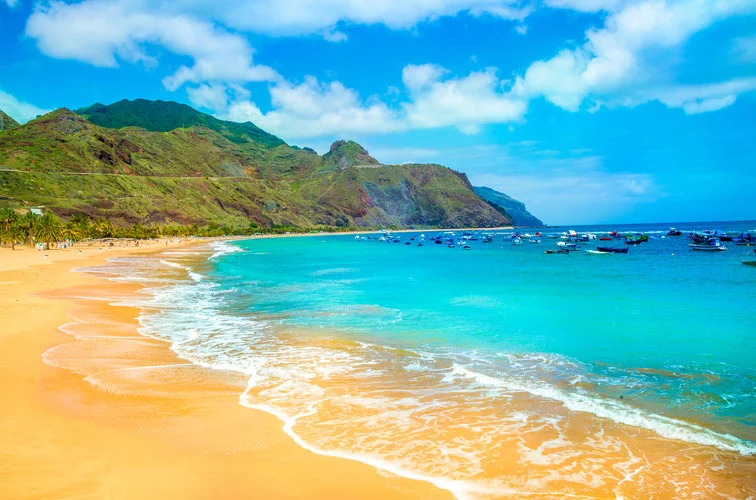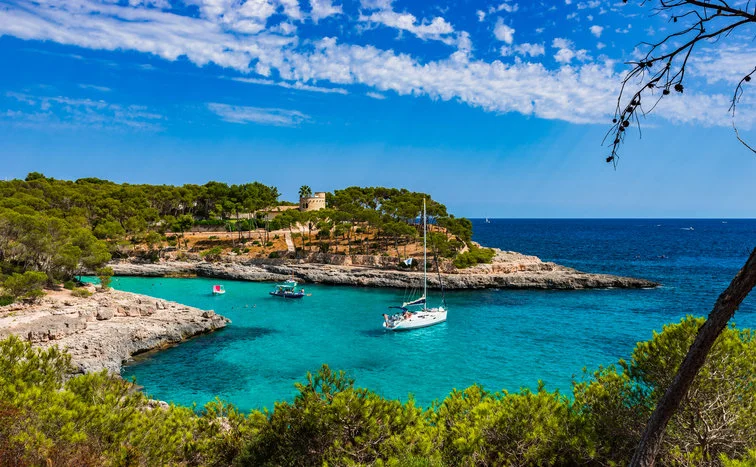A complete yacht charter guide for your next sailing holidays in Spain.
In this sailing guide, learn all about:
Are you already familiar with the Spanish sailing regions and want to look at boat options for your next yacht charter? Then skip to:
Search listings: Boat rentals in Spain
Let’s dive right in.
A yacht charter in Spain offers the chance to set sail into different sailing grounds, like the Balearic Islands, the Canary Islands, but also parts of the Spanish coastline.
Discover sandy beaches and breath-taking landscapes and make sure you don’t miss the national park of Puerto de Cabrera on a charter starting from Palma de Mallorca.
Let’s get started!

This beautiful group of islands, which consists of 7 larger islands:
and a few smaller ones:
They have splendid beaches of fine sand, warm climate and ideal sailing conditions year round.
Tenerife, the largest of the Canary Islands, benefits from the so-called Canaries cold-stream, which has a moderating effect on its climate, and from the refreshing trade winds, so greatly appreciated by sailors.
You might be wondering:
Are the Canary islands for those looking for exhilarating sailing?
Yep, they are; Especially for those!
The Canary Islands are one of Spain's top sailing destinations.
But what about the budget?
A Yacht charter in Canary islands is also ideal for a winter-sun escape on a tighter budget, as its proximity to Africa offers warm weather conditions year-round and yachts there are offered at lower prices than those one can find in a South Pacific or a Caribbean charter.
It’s a win win!
These islands are often called "The Islands of Eternal Spring"; the temperature ranges between 20 - 28 degrees Celsius in both summer and winter.
Almost always charterers enjoy moderate, fresh winds of 3-4 Beaufort, with stronger gusts between the islands due to the funnelling effect.
We recommend the Canary Islands to our more advanced sailors or those looking for a new, more challenging sailing experience.
Most yachts are based in Tenerife (Marina Del Sur) and Lanzarote (Marina Lanzarote). Lanzarote is well-served by the Lanzarote Airport. For Tenerife, you will need to fly in and out of the North or South Tenerife Airport, which have frequent flights from Europe and the USA.
We recommend allowing some time each day ashore for you and your crew to explore the amazing scenery of these islands.
You shouldn't miss the “Timanfaya National Park” and a walk to the majestic cliffs of Famara, which offer a breathtaking view over Europe’s largest marine protected area – the Chinijo archipelago.
⚓ Day 1: Embark your yacht at the Santa Cruz Marina, Tenerife (check-in)
⚓ Day 2. Santa Cruz - San Sebastian 28ΝΜ
⚓ Day 3. San Sebastian - Puerto De Tazacorte 60NM
⚓ Day 4. Puerto De Tazacorte - La Restinga 65NM
⚓ Day 5. La Restigna - Puerto de Valle Gran Reyiseros 45NM
⚓ Day 6. Puerto de Valle Gran Reyiseros - Los Gigantes 25NM
⚓ Day 7. Los Gigantes - Santa Cruz de Tenerife 14NM
⚓ Day 1. Tenerife (check-in)
⚓ Day 2. Santa Cruz de Tenerife
⚓ Day 3. San Cristobal de la Laguna
⚓ Day 4. Las Palmas de Gran Canaria
⚓ Day 5. Exploring Las Palmas
⚓ Day 6. Las Canteras Beach
⚓ Day 7. Fuerteventura Island
⚓ Day 8. East Coast of Fuerteventura
⚓ Day 9. Corralejo
⚓ Day 10. Lanzarote
⚓ Day 11. Betancuria
⚓ Day 12. Gran Canaria
⚓ Day 13. Tenerife

A Balearic yacht charter offers white sandy beaches, amazing nightlife, picturesque villages and breathtaking mountain and ocean views.
Want to know the best part?
The Balearic islands have what the locals call "un poco de todo" - a little bit of everything to satisfy even the most demanding of travellers.
But this is not the only thing they offer.
Mallorca and Ibiza offer excellent nightlife, sailing and snorkelling opportunities and a year-round stable climate.
Keep on reading: Mallorca sailing guide>>
During ancient times, these ideally located islands were the sailing crossroads of the Mediterranean.
Balearic islands are ideal for more experienced sailors.
Here’s the deal:
With more than 300 days of sunshine every year, the Balearic Islands are a sailor's paradise.
The best sailing conditions are between June and September and the prevailing wind is a NW Tramontana/Mistral.
The temperature ranges between 20-25 degrees Celsius in the summer months and the almost constant cooling breeze provides a relief from the heat of the day.
Due to the fact that the vast majority of yachts are based in Mallorca, we do recommend starting your holiday from this island.
But how can you go there?
You can fly in and out of Palma de Mallorca Airport and charter out of one of the many marinas (i.e. Marina Port De Mallorca or Palma Cuarentena).
Is there any alternative starting-point besides Mallorca or Palma?
Another option would be to start your holiday in Ibiza; should you wish to sail from Ibiza, we suggest booking your yacht early in the year, as there are few fleets based there and they get booked very quickly.
Is there something you shouldn’t miss while sailing around balearics?
You should definitely visit Cabrera, an uninhabited island near Mallorca - now a preserved National Park. You can book your stay in Cabrera in advance (the sooner the better due to high demand).
Please note:
Each yacht is only allowed to stay there for one night.
There are various anchorages with many town harbours around the coast, as well as organised marinas.
⚓ Day 1. Palma (check-in) - Puerto Andratx 17NM
⚓ Day 2. Puerto Andratx - Puerto Soller 25NM
⚓ Day 3. Puerto Soller - Puerto Pollensa 35 NM
⚓ Day 4. Puerto Pollensa - Cala Rajada 25NM
⚓ Day 5. Cala Rajada - Cala d’Or 18NM
⚓ Day 6. Cala d’Or - Cabrera Island 30NM
⚓ Day 7. Cabrera - Palma de Mallorca 35NM
⚓ Day 1. Palma (check-in)
⚓ Day 2. Port de Andratx
⚓ Day 3. Port de Soller
⚓ Day 4. Exploring the town of Soller
⚓ Day 5. Port of Pollensa
⚓ Day 6. Cala Sa Calobra
⚓ Day 7. Cala Ratjada
⚓ Day 8. Porto Cristo
⚓ Day 9. Portocolom
⚓ Day 10. Cala Figueras
⚓ Day 11. Cabrera
⚓ Day 12. Colonia San Jordi
⚓ Day 13. Palma

Did you know that Costa Brava is one of Spain’s best kept secrets?
Well, it’s true!
Authentic and artistic, the Costa Brava has maintained its quaint and special charm.
While it is still popular with tourists, it’s the perfect destination to escape it all and immerse yourself in rest and relaxation, while surrounded by amazing scenery and culture.
What to visit around Costa Brava?
Visit interesting villages like the medieval town, Besalú, or the white-washed Cadaqués, or the seaside towns of Calella de Palafrugell and Llafranc.
Enjoy delightfully fresh seafood and al fresco dining in town - or from your yacht’s deck.
It gets better.
Meaning ‘wild coast,’ Costa Brava has some of the most amazing coastline, with rocky jagged cliffs framing the aqua blue Mediterranean waters in the hidden calas that you can only reach by boat.
Walk the coastal paths that once connected fishing villages in the 19th century.
Bottom line?
Regardless of what you choose to do, a yacht charter in Costa Brava will be the experience of a lifetime!
The best time for sailing Costa Brava is during between June-August when you can enjoy those long hot Mediterranean summer days.
However, as Costa Brava enjoys mild weather almost all year long, the shoulder season of May and June are also lovely times to go.
Now:
Considering that Costa Brava has 300 days of sunshine a year, and an average humidity of about 70%, there really isn’t a bad time to visit Costa Brava.
Average summer temperatures range from 27-30°C, and water temperatures of 23°C. Winter averages are between 8-12°C and water temperatures of 11°C.
Summer is the driest season in Costa Brava, and you might see a bit more rain in the shoulder months. October is considered the rainiest time, with average monthly rainfall of about 90mm.
As for winds, there is the Tramuntana which blows from West to Northwest in the mid-pyrenees and Perpignan regions. On the Mediterranean you’ll get northerly wind following the Bear, Creus and Begur capes. You’ll also get strong winds more frequently during October-April.
Option #1:
The best way to get to our base located in Empuriabrava, is to fly into Barcelona’s international airport, which is about 163km from base.
As the second largest airport in Spain, there are several flights daily from the UK, North America and the rest of the EU.
From Barcelona-El Prat Airport:
You can either go by car directly to base, or head into the city center and take the train to Figueras and then a taxi to base.
Option #2:
Alternatively you could fly into a smaller regional airport in Perpignan, or Girona, which are both a bit closer to Empuriabrava.
If you would like help organizing airport transfers, ask your charter consultant!
You might be wondering:
What language do they speak in Costa Brava?
Well, In Costa Brava, the predominant languages are Catalan and Spanish.
Catalan is a regional dialect, but don’t worry most everyone you meet will know Spanish, and even some English as well.
For mooring:
Anchoring in the sand is allowed, but stay away from seaweeds and grasses.
If available, use a mooring buoy. If not, try to make sure you are not over a seagrass bed.
Restoring a seabed takes many years, but you can prevent any damage by diving under to patrol the area before anchoring. You can also tell by checking the coloring for the area below you. Light patches are likely sand and darker patches are usually seaweed or seagrass.
For provisioning:
Yacht4Less recommends Mercadona, which is a mere 8 minutes all. Here you can order online and arrange for delivery to your yacht. Ask your charter broker about it and we would be happy to arrange your provisioning for you!
It depends. There are many factors that can shape a yacht charter cost. Find below the cheapest yacht charter prices in Spain today:
*disclaimer: Be aware that the prices change instantly every minute and there may be slighlty cheaper boat listings.